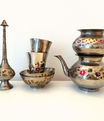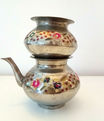
Plants & Gardens
Living History
Objects
from Public & Private Collections
Synesthesia
Perfume & Flavour Translations
The Process
Notes between the historian and perfumer
June - August 2021

Bharti:
Nicolas, help me read this painting that you've selected for our scent translation: Maharana Jagat Singh II celebrating the Festival of Flowers in the Gulab Bari Garden (1750)
- is it summer? The celebration in the rose garden is obvious but what do the overall registers of the painting tell us? I would list rose, saffron, cypress, wine, honey, horse/ hay/ dung, perhaps a fruit (mango), and maybe nutmeg for the perfume. Can you identify the trees?
Nicolas:
It is spring; the lowest register shows the Rana processing to the garden, and the upper register sitting in the garden with his nobles, with a group of entertainers at the right. Among the piles of rose garlands there are also poppies and larkspur on the platters on the chabutra. I think rose, cypress, wine, and horse/ hay definitely make sense. Perhaps also charcoal/ash, as associated with the sanyasis/ Shiva that the entertainers are imitating. And there appears to be an actual sadhu sitting near the elephant in the forecourt. The trees appear to be generic leafy trees, probably figs of various sorts (peepal, gular…).
Bharti:
But poppies and larkspurs have no discernable scent.
Nicolas:
They possess a narcotic powderiness...
Bharti:
Perfume composition:
Floral: Rose absolute, rose oil (Indian), pink pepper co2, frangipani, touch of jasmine, champaca flower, orange flower absolute (Tunisia), heliotrope + alpha irone, alpha ionone, coumarine, rose aldehyde for powderiness.
Spice + Fruit: saffron, floral nectar/ honey, mango/ peach for sweetness
Resin: Labdanum/ rock rose, poplar bud absolute, tobacco absolute, benzoin
Wood: sandalwood, vetiver, mitti/ petrichor accord in dilution, oud, fresh mown hay note
Musk: A full bodied animalic funk lurking beneath the freshness of the rose garlands with civet, ambergris and a leather accord to mimic perfume and perspiration.
Nicolas:
The first draft of perfume samples you sent - The rose sweetness comes out more over time, but that seems like an inverse of the experience in the garden. Same for Painting No. 2: luscious but missing spring floweriness/ brightness/ breezy quality of spring-winter flowers.
Sample for Painting No. 3 works really well - it is the most immediately evocative for me
Bharti:
Samples for painting 1 and 2 are attar/ oil based concentrates. Sample for Painting 3 was diluted in alcohol.
The experience and expectation of the medium of dilution should be explained as the same perfume-concentrate fixed in alcohol or oil will perform differently from one another.
While alcohol allows the top notes to shine, scintillate and sparkle in the air - due to its fast evaporation rate carrying scent-molecules with it - Oil-based attars enjoy longevity on the skin due to a much slower rate of evaporation. This would explain your experience of sample 3 as ‘immediate’ vs samples 1, 2 as ‘garden in inverse’.
Attar-perfume will yield a full power density and intensity that becomes sweeter and lighter over time as opposed to alcohol dilution that enables a floaty-breezy quality to aroma molecules such as aldehydes. Ever smelled Chanel 5 in cold weather? The smell of clean skin combined with a floral citrus boom? Aldehydes magic. The same perfume smells awful in summer/ humid climate as aldehydes would under-perform. The same 'clean skin smell' simulates the smell of sweat.
Having said that, I don’t mean to imply that alcohol-dilution is superior to the attar-version. There is the question of access: For whom is this project? Who is the audience?
These perfumes, like the mood and landscape of these paintings are specific to the South Asian context and palette. Alcohol-perfumes would be somewhat exclusionary. Hence the decision to keep the perfume-dilution in ethical sandalwood oil which in itself is a signifier of old world luxury and dare I say, 'authentic' to the historic lineage of perfumery in the sub-continent. The pragmatic aspect of this decision also means we can commission artistic handblown glass bottles.
Nicolas:
This makes sense.
Bharti:
Edible Perfume component - The rich soil/earth/petrichor note in this painting will be simulated in a dark chocolate spread created with vetiver, groundnuts and jaggery. I would like to create a rose sugar to accompany this chocolate. The perfume-sugar should feel like a mouthful of flowers - but I am not sure.
Nicolas:
Yes! I want you to make that. Dates and poppy seeds are appropriate.
Bharti:
I've prepared the rose sugar with rose and sandalwood CO2 extracts for dusting the dates. Thickened desi gulab jam is then sectioned into tiny bits dusted in corn starch (like marshmallows or Turkish delight) and mixed in with the dates and poppy seeds. As the mushy rose bits appear indistinguishable from the dates, I expect the audience to assume they are biting into a date but then are unexpectedly hit with a mouthful of 'roses'.
Your imagination of the painting included a 'powdery, fresh, breezy, spring floral' quality - I am incorporating these facets in the incense and tea. The tea is composed of rose petals, bergamot, mint and black tea leaves. Brewed for 6 minutes, it feels like drinking a fresh rose blossom.
The incense is made by a local workshop to my extracting prescription: mild rose bouquet, powdery and subdued.
Bharti:
Given the opportunity, I would love to expand this perfume-interpretation of the painting. There is so much going on in each register, that I would present the 'Rose garden' in a main amphora, with two different accords representing animalic musk and trees/smoke notes. This would allow the perfume to function like sound, giving more control to the audience to increase or decrease the volume of rose versus musk or smoke, adding a playful dimension to the medium of smell, bending the expectations of how perfume is supposed to be consumed.
While I prepare the final version of perfumes and synesthesia elements to send your way, tell me more about what you grow, in particular the roses?



Nicolas:
Much of my gardening, especially in recent years, has actually been in close conversation with my academic research on the one hand and my travels on the other. My garden has really become a place where I try to bring together plants that are prominent in the texts and artworks that I study and those that for me define the horticulture and/or landscape of particular places important to me. These include India, where much of my research is centered, but also Portugal, where my family has vacationed throughout my life, and Malaysia, where my partner is from.
I grow Shirley or corn poppies and larkspur together, for instance, a combination that was extremely popular in seventeenth- and eighteenth-century South Asia, as attested by both literary references and paintings. Among roses, my favorites include the old Damask strains traditionally used to make rosewater, such as 'Kazanlik' and 'Gloire de Guilan,' as well as quintessential desi gulab varieties like 'Gruß an Teplitz' and 'Kakinada Red'.



































































